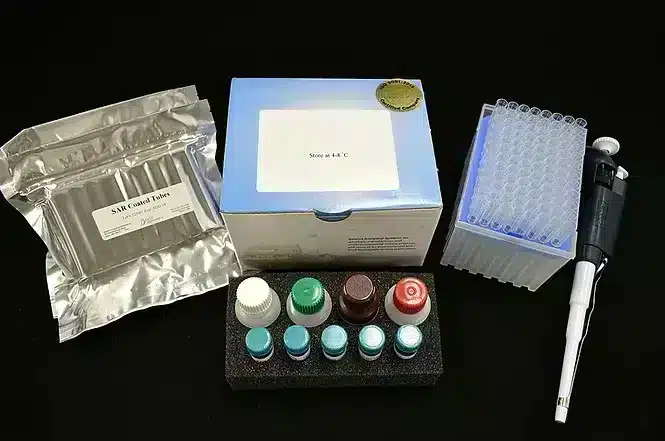EndoAlert® Plate Kit
INTENDED USE
The EndoAlert Plate Kit is a kinetic, colorimetric assay for the quantitative determination of bacterial Endotoxin in aqueous solutions. Endotoxin, a bacterial lipopolysaccharide, is one of the major cell wall components of most gram-negative bacteria. The EndoAlert Plate Kit detects low levels of Endotoxin and is therefore a useful tool to assess the integrity of biological and environmental samples. The detection ranges from 0.01 – 10 Endotoxin units (EU/mL).
MATERIALS PROVIDED IN THE ENDOALERT PLATE KIT
3 Vials Chromogenic Lysate Lyophilized
1 Vial Endotoxin Standard 10 EU/vial Lyophilized
1 Bottle LAL Reagent Water (LRW) 10 ml
1 Piece 96-Well Microtiter Plate
SKU:
BAS-20-0321
Category: Endotoxins
Description
USE PRINCIPLES
The EndoAlert® Plate Kit is a quantitative version of the reaction first described by Levin and Bang in 1968. The test is based upon an enzymatic cascade where Endotoxin activates Factor C in Limulus Amebocyte Lysate (LAL) which in turn activates Factor B. Factor B activates Proclotting Enzyme which then activates Clotting Enzyme. A colorless synthetic peptide substrate is hydrolyzed by Clotting Enzyme to generate a yellow color which can be measured by a spectrophotometer at 405nm. The degree of color resulting from the reaction is proportional to the amount of Endotoxin in the test sample and can be calculated using a standard curve.
Bacterial endotoxins, found in the outer membrane of gram-negative bacteria are members of a class of phospholipids called lipopolysaccharides (LPS). LPS are not exogenous products of gram-negative bacteria, implicated in the development of Gram-negative shock. The release of LPS from bacteria takes place after death and lysis of the cell. They can cause adverse reactions in sufficient concentrations, such as fever, hypotension, pulmonary edema and disseminated coagulation events in humans and animals, by release of inflammatory mediators, such as cytokines and interleukins. For example, endotoxin reacts with lipopolysaccharide-sensitive cells producing tumor necrosis factor alpha (TNFα). Macrophages are cells mediating the toxic activities of LPS, and TNFα is the primary mediator of the lethal action of endotoxin.
Pyrogens include endotoxins (toxins derived from gram-negative bacteria) and non-endotoxic pyrogens (substances derived from microorganisms other than gram-negative bacteria, or from chemical substances). Endotoxins from gram-negative bacteria are the most common cause of toxic reactions due to contamination of pyrogenic compounds. Good examples of pyrogen producing gram- negative bacteria are Escherichia coli, Proteus, Pseudomonas, Enterobacter and Klebsiella. Due to its heat resistance and stability, complete inactivation of endotoxin is not possible with autoclaving. Dry heat sterilization for at least 30 minutes at a temperature of 250 °C or more is required complete inactiocaiton. It exists in the environment (e.g., water, air) inhabited by gram-negative bacteria, and bacterial endotoxins (LPS) remain even after the bacteria die.
PURITY AND SPECIFICITY
This kit includes: 96-well plate, endotoxin standard, chromogenic lysate (~60 reactions), LAL reagent water. See kit protocol for complete details. The EndoAlert™ Endotoxin Plate Kit provides a level of Endotoxin only in relation to the standard. The EndoAlert™ ES Endotoxin Plate Kit is specifically formulated to detect and react only with endotoxin and is unreactive to (1,3) B-D glucans which are cell wall components of fungi. The EndoAlert™ ES Endotoxin Plate Kit provides a level of Endotoxin only in relation to the standard. It is NOT specific to the species of gram-negative bacteria which is the source of the Endotoxin in the sample. To increase accuracy of the test when the source of Endotoxin is known, use a purified Endotoxin from that species.
Additional information
| Format: |
96-well microtiter plate |
|---|---|
| Standards: |
Lyophilized Endotoxin (10 EU/vial) |
| Incubation Time: |
60 minutes |
Shipping & Delivery

